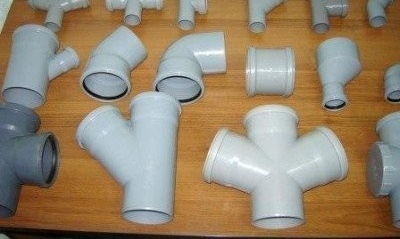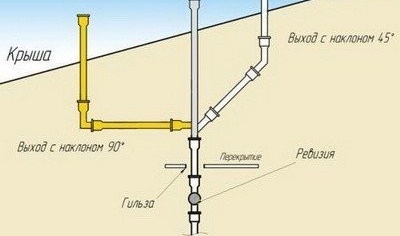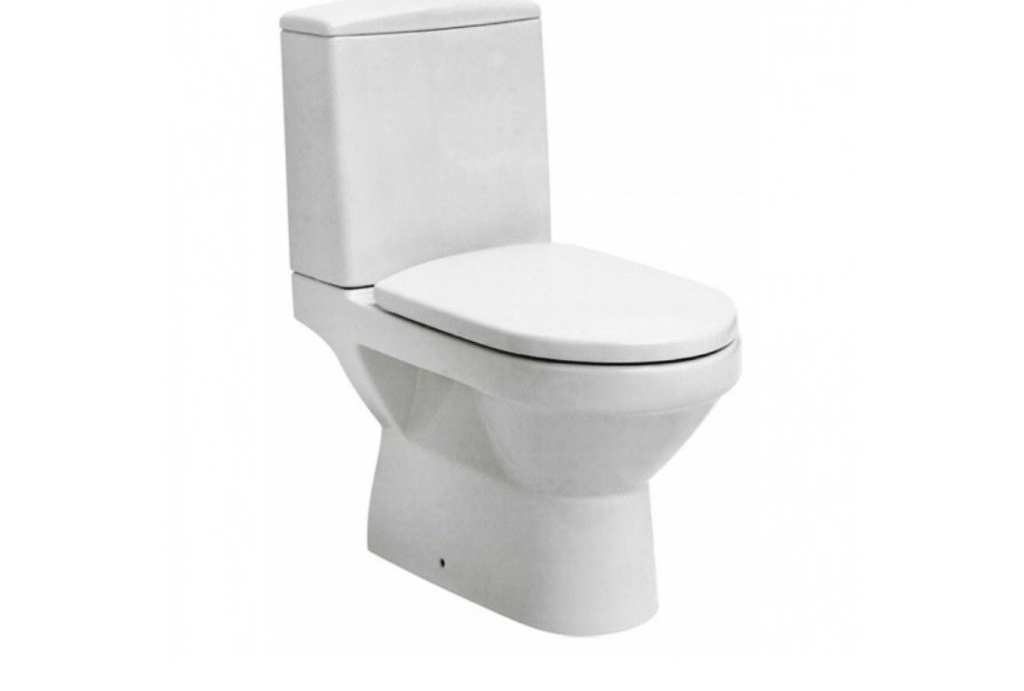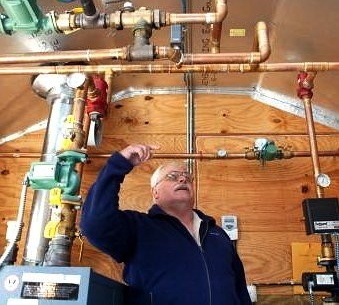The device of the fan riser: how to properly install and avoid mistakes

Modern housing is replete with all kinds of communications. One of the most important among them can be considered sewage, which allows collecting and discharging waste water. A feature of her work is the presence of so-called sewer gases, which are an unpleasantly smelling mixture of methane, ammonia and other similar substances. The penetration of these gases into the room is highly undesirable. To prevent this unpleasant phenomenon, a special protection system is installed, the main element of which is a fan pipe. The device maintains pressure in the system and successfully discharges sewer gases.
Content
Why do you need fan ventilation?
Obligatory equipment for fan ventilation is provided for by building codes. The explanation is very simple. Gases, which are inevitably present in the sewers, accumulate over time and look for a way out, heading towards the living room. On their way are hydraulic locks of plumbing equipment. These devices, which are specially curved siphons filled with water, can withstand a rather large back pressure up to a certain point. However, at certain values, the water locks cannot withstand, and sewer gases burst into the room.
Another reason for the appearance of an unpleasant smell in the room is the banal failure of the water shutter. It occurs at the moment when sewage drains cover the entire diameter of the riser. Immediately there is a vacuum and vacuum, which sucks air in the pipe and water in the siphons of the devices. After pressure stabilization, it turns out that the water trap is empty, and sewer gases freely enter the room. Contrary to popular belief, it is unlikely that a water lock for plumbing such as a toilet bowl or sink is unlikely to occur. Precipitation or contamination on the walls of sewer pipes reduces their diameter, which makes an emergency quite possible.
A fun riser will help to cope with the problem. This is a pipe that connects the sewer to the atmosphere. The design is most often displayed through the roof. The principle of operation of the device is quite simple. When a vacuum occurs in the system through the fan pipe, air enters, which maintains normal pressure, thereby preventing the breakdown of hydraulic locks. Alternatively, a non-return valve can be worn on the fan pipe, which allows the system to function efficiently even without venting the riser to the roof.
System Design Principles
A fan ventilation system may be a single exhaust pipe or a branched structure. In any case, its design is subject to the following requirements:
- The diameters of the installed fan pipes cannot be less than the diameter of the sewer riser to which they are attached.
- Horizontal sections of the system are laid with a slope of at least 0.02% in the direction of gas movement.
- With the help of one fan pipe several risers can be combined at once.
- Changing the direction of the fan pipe can only be performed above the level of the last device connected to the riser.
- When connecting several pipelines, a fan tee is used, which is installed at an angle of 135 ° or 45 ° in the direction of gas movement.
- All changes in the direction of the system are carried out only through the fan tap at an angle of 135 °.
- The fan ventilation riser must rise above the roof to a height of 0.3 to 0.5 m. If the roof is used or the attic is used as a living room, the pipe outlet must be at least 3 m.
- The distance from the riser to the nearest balcony or window cannot be less than 4 m horizontally.
- The joint conclusion of the fan pipe, ventilation system and chimney is prohibited.
To improve traction in the riser, its lower part should always be in a warmer (heated) room, and the upper one should be in a cold one. Installation of the structure on the external wall of the building is not allowed. Such a system will not work. According to SNiPs, the fan system is mandatory to be installed in multi-storey buildings, in buildings where the sewage system has an autonomous hermetic accumulator, in houses where the sewer system is equipped with pipes whose diameter is 50 mm or less.
Preparing for the installation of the fan trunk
For the arrangement of fan ventilation, the same elements are used as for the sewer system: fasteners, pipes and fittings. Accordingly, before installing a new design, you will need to prepare the necessary number of parts. The most commonly used plastic elements. Everything will be somewhat more complicated if replacement of the old design is required. Consider this option a little more.
Spent their pig-iron sewer-pipe pipelines fail. Is it possible to change them to more convenient plastic ones? Unambiguously affirmatively this question can be answered only if the entire sewer system changes to plastic. Experts say that pipes different in material lead to a decrease in the strength of the fan trunk. It is optimal to work with materials of the same type identical to the sewer riser pipe. That is, if the outlet pipe is made of cast iron, then the fan line should ideally be cast iron. If nevertheless for some reason this is impossible, you should consult with experts on how the new pig-iron-plastic line will behave. This will help prevent a possible decrease in the performance of the fan system.

For the arrangement of the fan system, ordinary sewer pipes and connecting parts are used. They can be both cast iron and plastic
For installation, you will need a pipe with bends, rubber cuffs to ensure a tight seal, adapters, clamps for fixing the pipeline to the wall. If you have to start by dismantling the old system, then a grinder, drill and sledgehammer will come in handy. The installation site is cleared, all unnecessary is removed. If flammable stationary objects are nearby, they should be covered with a refractory coating. During work, it is undesirable to use sewage. This should be notified in advance to the neighbors, if any.Then the riser is turned off, and if necessary, work is carried out to dismantle the old system.
Installation of a new design
Installation of a fan pipe for a toilet starts from the lower main line or from the foundation level of a private house. Holes are made in the wall where the clamps will be fixed. It is better to choose more reliable metal mounts, which also give the structure strength. The pipeline is mounted and securely fixed with clamps. Fan bends must be brought to the plumbing equipment and firmly fixed. To ensure that the pipe connection to the main line is reliable, O-rings are used. Experts recommend mounting them with silicone or liquid soap. In this case, the connection will be more tight, however, its subsequent dismantling will be somewhat difficult.
To protect yourself from unpleasant sounds from the riser, you can equip sound insulation. The easiest option is to process the pipe with foam. It perfectly absorbs all the noise from the highway, but also creates problems when conducting work on the audit and maintenance of the system. Therefore, a more acceptable option, which, moreover, is the only one when arranging complex wiring, is the use of a mineral wool slab for sound insulation. You can use a special soundproof box, equipped with a window for revision.
Check valve for fan riser
The device of a standard fan riser suggests that the pipe is displayed on the street most often through the roof. She does not require any additional devices to help her function normally. However, for a number of reasons, it may be necessary to install a riser that does not have a roof outlet. In this case, you can not do without a special device, which is called check valve. The design is equipped with two openings with air-tight cuffs.
The device operates very simply. Weak springs installed under the cuffs are compressed when a vacuum occurs in the system. The holes open and the valve begins to suck in air, thereby equalizing the pressure in the riser. As soon as it returns to normal, the valve closes. The device not only does not allow unpleasant odors to appear in the room, but also prevents:
- mechanical impurities entering the system;
- return of drains to the sanitary equipment;
- penetration of rodents into the room.
There are several varieties of check valve. The device can be mounted outside or inside the fan pipe. Internal installation involves the installation of a special insert, which is not included in the kit and must be purchased separately. Before installation, the pipe is thoroughly cleaned of possible contaminants and degreased. The valve is placed in the direction opposite to the movement of the effluents, so that the petals are bent towards the plumbing equipment.

A check valve or, as it is also called, a vacuum valve is installed on the fan pipe. In this case, the conclusion of the structure to the roof is not required
Typical installation errors
When installing a fan ventilation system, inexperienced builders can make mistakes. The most common are:
- Conclusion of the fan pipe into the attic. This decision seems justified to those who do not want to bother with arranging the roofing adjoining the attic pipe. The result will be the accumulation of sewer gases under the ceilings and their penetration into the premises of the upper floor.
- Fastening to the riser various exhaust devices such as a fly-gun or deflector. Inexperienced developers are confident that in this case the traction will be better. But this is not so. This solution leads to the appearance of condensate in the system, which, when freezing, blocks the outlet openings, and to a deterioration in the outflow of gases.
- Installation of the fan pipe along the external wall of the building.In the cold season, condensation will form inside the structure, which impedes the normal operation of the system.
- The output of the pipe under the overhang of the roof. Here it can easily be damaged by snow sliding from the roof.
The installation technology of the fan system is quite simple. It does not matter whether it is a matter of replacing the old design or installing a new one. You only need to carefully read the instructions and strictly comply with all the requirements of building codes. If you wish, you can install the design yourself or, if you are unsure of your abilities, you can invite plumbers. They quickly and competently mount a system of any complexity.




